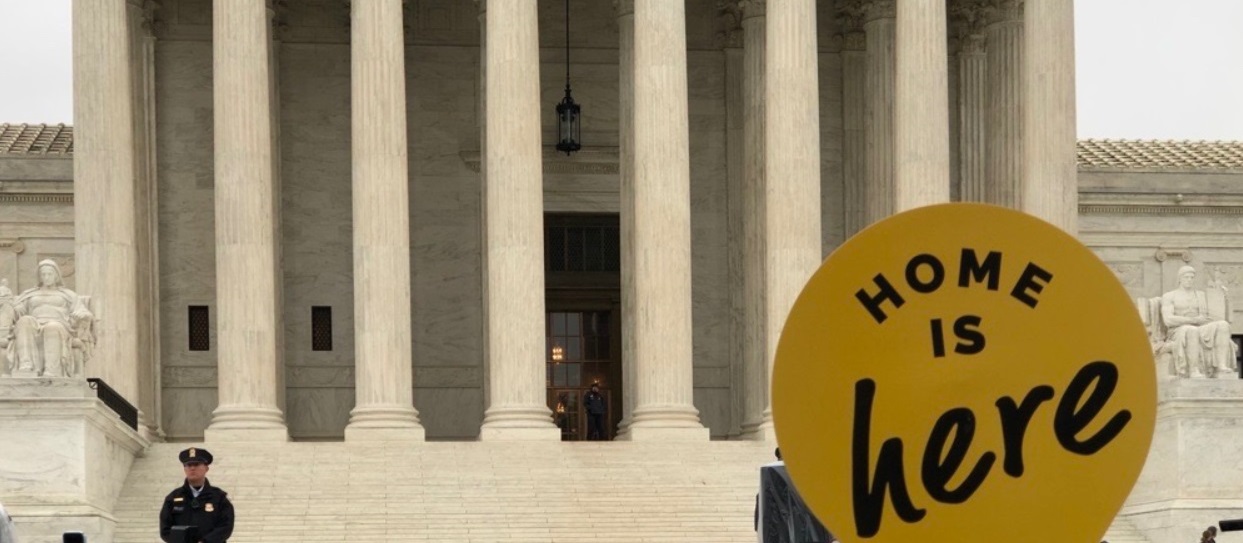The Supreme Court issued its long-anticipated decision in DHS v. Regents of the University of California—the case challenging the administration’s attempt to dismantle the Deferred Action for Childhood Arrivals (DACA) initiative.
The Court ruled on June 18 that the administration did not adequately explain its decision to end DACA and its reasoning to do so was faulty. A majority of the justices agreed this violated the Administrative Procedure Act (APA).
This decision is life-changing for everyone who has benefited from the DACA initiative. It’s also meaningful for advocates who have worked alongside Dreamers for years to help ensure they could continue living and working in the United States without the constant fear of deportation. The decision is ultimately a win for the rule of law.
Though the president could still end the program, the decision will provide peace of mind to hundreds of thousands of Dreamers who have been building their lives in the United States for years.
The DACA initiative was first announced in June 2012. It’s allowed certain undocumented immigrants who arrived in the United States as children to apply for protections from deportation and the ability to work in the country lawfully.
Approximately 800,000 people have participated in DACA since it was first announced. Around 650,000 people are currently enrolled. Three lawsuits challenging the decision to dismantle the program forced the administration to continue accepting renewal requests from people who were previously enrolled.
The program is very popular with Americans. Most of the country supports protecting Dreamers, including 69 percent of the people who voted for President Trump in 2016.
What was the Supreme Court’s decision?
The Court did not decide the issue of whether DACA is legal. Instead, it ruled that the administration’s decision to terminate the initiative was “arbitrary and capricious” and that it was made in violation of the APA.
The APA governs agency actions such as the issuance of major policy changes, requiring administrative agencies to explain their reasons for changing policy. It provides the standards for judicial review of claims challenging agency actions that impact people in the United States.
In reaching its decision, the Court had to first decide if the administration’s decision to terminate the program was one that could be reviewed by the courts, and, if so, if the administration’s attempted rescission was consistent with the terms of the APA.
The Supreme Court said the decision to rescind the program can be reviewed.
The administration claimed that its effort to terminate DACA was not subject to judicial review. It argued that DACA was simply a discretionary decision to not institute enforcement actions against individuals and therefore exempt judicial scrutiny under the APA. The administration cited the “deferred action” – or protection from deportation – that DACA provides to its recipients as this sort of “non-enforcement” policy.
The Court agreed that this aspect of the program constituted a “non-enforcement” policy. But a majority of the justices highlighted the additional benefit that the program provides: allowing recipients to obtain employment authorization.
This authorization, in turn, makes DACA recipients eligible for Social Security and Medicare. This makes the DACA initiative more than just a “non-enforcement” policy. Given that courts are often called on to protect people’s interests in Social Security and Medicare benefits, the Supreme Court found that judicial review was justified.
The way DACA was rescinded violated the APA.
The Court found that the Department of Homeland Security failed to exercise its discretion in a reasonable manner.
In reaching this conclusion, the Court focused on former Acting DHS Secretary Elaine Duke’s claim that the DACA program was simply “illegal” as a justification for its revocation in 2017.
Her one-sentence justification for ending the program was based on the advice of former Attorney General Jeff Sessions that the DACA program was illegal. The Attorney General reached his conclusion after separate litigation successfully challenged a program known as Deferred Action for Parents of Americans (DAPA).
But the decision in that case was based on the added benefit of employment authorization and not the “non-enforcement” portion of the policy. Given that Acting Secretary Duke could have used her discretion to address employment authorization without attacking the protections from deportation—and given the potentially severe consequences to DACA recipients associated with her failure to do so—the Court found that her decision was improper.
The bottom line is that the administration has the authority to rescind DACA, but it failed to follow the necessary steps to do so lawfully.
What does the Supreme Court’s decision mean?
The DACA program stands and should continue operating as initially created in 2012. This means that current DACA recipients will continue to be able to renew their protections. Importantly, young people who became eligible for the program since the initial rescission was announced in 2017 should now be permitted to participate as well. Whether or not DACA recipients will once again be able to obtain advance parole to allow them to travel abroad and reenter the U.S. lawfully remains an open question.
The administration could once again decide to rescind the program, but it would have to articulate its reasons for doing so, considering all relevant factors.
It could also attempt to change the underlying regulation that makes DACA recipients eligible for employment authorization.
The administration may have to provide an opportunity for the general public to comment on either proposal – a process that is time-consuming and unlikely to be completed before the election this fall.
We all want a fair shot at the American dream. Given the widespread popularity of the program, the contributions made by Dreamers to their communities, and the need to finally and officially make America their home, the administration and Congress should create a permanent solution with a path to citizenship for Dreamers .
Photo by Maria Frausto
FILED UNDER: DACA, Donald Trump, Supreme Court


